Kaishi Paper (Traditional Japanese Paper): Versatile Uses for Dining and Daily Life
Oct 10,2014
Kaishi Paper (Traditional Japanese Paper): Versatile Uses for Dining and Daily Life
Oct 10,2014

What comes to mind when you hear the word kaishi? I suspect many of you associate kaishi as items tea ceremony participants need. Perhaps, more of you are not sure how best to use kaishi.
On the other hand, we catch sight of magazines and books describing kaishi as must-haves for attractive women and a social grace of accomplished women. To get a better understanding of kaishi, we spoke with Kubo Kanako, a food researcher, about the elegant and fitting uses of kaishi, starting with how to use kaishi to eat Japanese cuisine with more sophistication.
The word kaishi is formed from two characters: kai meaning inside pocket and shi meaning traditional washi paper. The word literally means paper tucked away in one’s inside pocket. It harkens back to the times when people kept kaishi in their kimono, much like how we carry around small packages of tissue paper with us today. You can still find many types of kaishi in stationery stores and stores dealing in washi paper products. The most common of these are the pure white variety used in tea ceremonies and other formal occasions. This type are bundled and carried while folded in two. Other kaishi vary in materials and patterns, ranging from those with houndstooth and other watermark patterns to those festooned with seasonal flowers, festive motifs, and colorful modern designs.

Manufacturers offer a tremendous variety of kaishi, such as those fabricated with gold leaf, those dressed up with seasonal flowers, those with traditional Japanese motifs, and those with bold modern designs.

The most common sizes are 145 x 175 mm for women (left) and 175 x 205 mm for men (right). However, different schools of tea ceremony may have slightly different sizes.
These days, the people most familiar with kaishi are those who attend tea ceremonies. The arrangement of lightly-infused matcha beside Japanese confectionaries resting on an unblemished kaishi sheet is an aesthetic marvel from any angle, infused with the wonder of time-honored beauty.
At the same time, Kubo laments that “it would be a shame to restrict kaishi to just tea ceremonies and Japanese sweets”. What makes kaishi remarkable is that if you have some with you, you will discover so many convenient uses for them. Let’s learn some practical tips on using kaishi for both women and men.

Kubo taught us in our second article on the etiquette of chopsticks and tableware that it is not a graceful gesture to use your free hand as a sort of “hand plate” while transporting food to your mouth. I’m sure everyone agrees, but what should one do when eating food piled on a plate too big to hold or when eating from a large Shokado-style bento box?
That’s where your kaishi come to the rescue. Hold one gently in your left hand to catch any drips of soup. What you should watch out for in this case, says Kubo, is that you normally use your kaishi in a bundle. “What makes kaishi so convenient is the crisp washi paper they are made from. By using them layered in a bundle, they have more presence and stability than tissue paper or paper napkins, which makes them easier to use.”
Kubo continues: “Small bones left over from fish or the skins of grapes or other fruit can make your plate look unsightly after eating. A very stylish way to deal with this is to fold your kaishi discreetly into a tent-shape to cover any scraps. You’d hesitate to do this with tissue paper because it would look messy. But the materiality of kaishi lets you pull it off.”

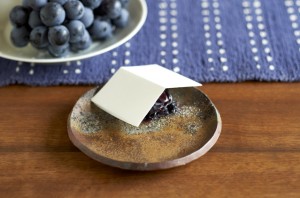
Folded kaishi can be used to gently wipe off drops that drip from the mouth of a saké bottle or saké pitcher or be made into a coaster to place under a chilled glass. Only kaishi can impart a casual beauty in these situations.
“A coaster made from kaishi with a modern pattern can be gorgeous and would be of great service at a garden party, for example. If, on the other hand, you were to place a pure white kaishi under, say, a cup of iced barley tea, I think it would have a neater and more refreshing presence than a coaster.”

People long ago used to carry kaishi with them in the inner pocket of their kimono, but few in modern times normally have any at hand. If you aren’t wearing a kimono, you should put your kaishi in a purpose-made case and carry it in your bag. Kaishi can be used in so many ways … as a classy tissue paper, as a makeshift memo pad, as wrapping paper for a small gift.
When you are serving a dish to a guest and the chopstick wrappers from the caterer are less than stellar … when you are returning a small sum you borrowed … at times like these, kaishi are a super stylish choice.


Kubo adds: “It’s useful if you learn how to make a simple paper envelope from kaishi. When you have to return small change or pay someone for something they purchased for you, a paper envelope makes it possible to pass money in a tasteful and charming manner.”

How to fold kaishi to make a small paper envelope
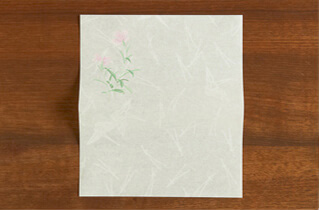
1. Take out a sheet of kaishi.
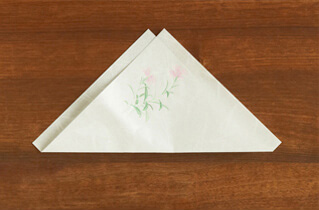
2. Fold it in half, making two little peaks.
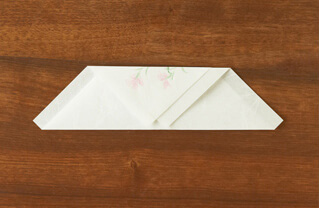
3. Place the sheet so the fold points down, slip the folded bills in between, and fold the top to meet the bottom edge.
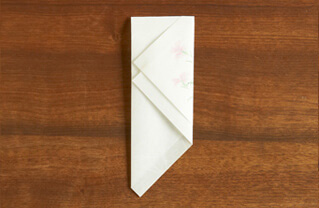
4. Turn the sheet 90 degrees and fold the top and bottom in, accounting for the length of the bills.
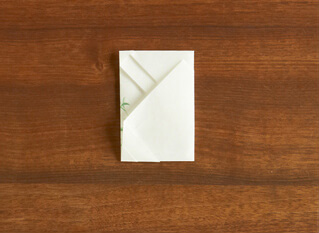
5. Flip the envelope over so it looks like the photo. Tuck the top into the bottom. Be sure to not do it the opposite way, which is reserved for funeral envelopes.
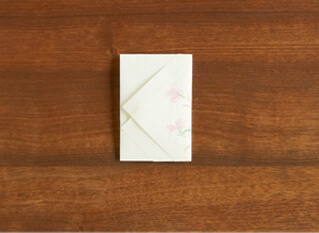
6. Flip it back to the front and you’re done.
Placing, wrapping, wiping, and writing. Kaishi are incredibly useful in so many situations. Try carrying some with you so you can take one out at any time, not just when having Japanese cuisine but also for casual parties or ordinary outings. You’re sure to find times where you are glad to have one and where kaishi prove their usefulness.
Like furoshiki wrapping cloths, kaishi are an ingenious, multipurpose amenity stemming from the creativity of Japanese culture. Try kaishi for yourself and experience their beauty and functionality.
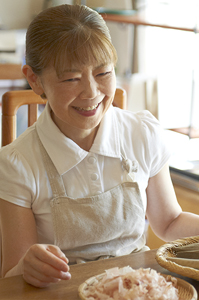
Culinary Researcher
Culinary Researcher
Growing increasingly interested in cooking, Kubo Kanako studied at the long-established Kyoto ryotei (high-class Japanese restaurant) Tankuma Kitamise from the time she was a high school student. After graduating from the Department of English at Doshisha University, she entered the Tsuji Culinary Institute, where she obtained chef’s and fugu (puffer fish) cooking licenses. Following a stint in the Tsuji Culinary Institute’s publications arm, she edited cook books at a publishing house in Tokyo, before going independent.
Today, Kubo is actively involved in a variety of culinary-related endeavors, including culinary production, styling, restaurant menu development, table decorating, editing and more.
She is the author of several works in Japanese, including Utsukushii morituske no kihon [Basics of Beautiful Plating] (Seibido Shuppan), Utsukushii ichiju nisai: “Oishii” to “kirei” in ha wake ga aru [Beautiful Soup and Two Dishes: There are Reasons for “Deliciousness” and “Beauty”] (Kawade Shobo Shinsha), Kichinto, yasai no kobachi chotto shita kotsu de “mō ippin” ga gutto oishikunaru! [Small Vegetable Side Dishes: Little Tips that Make That Extra Something So Much More Delicious] (Kawade Shobo Shinsha), Kichinto, oishii mukashinagara no ryōri [Delicious Old-Time Cooking] and Shun no aji techō aki to fuyu [Seasonal Flavor Handbook: Fall and Winter] (both Seibido Shuppan)